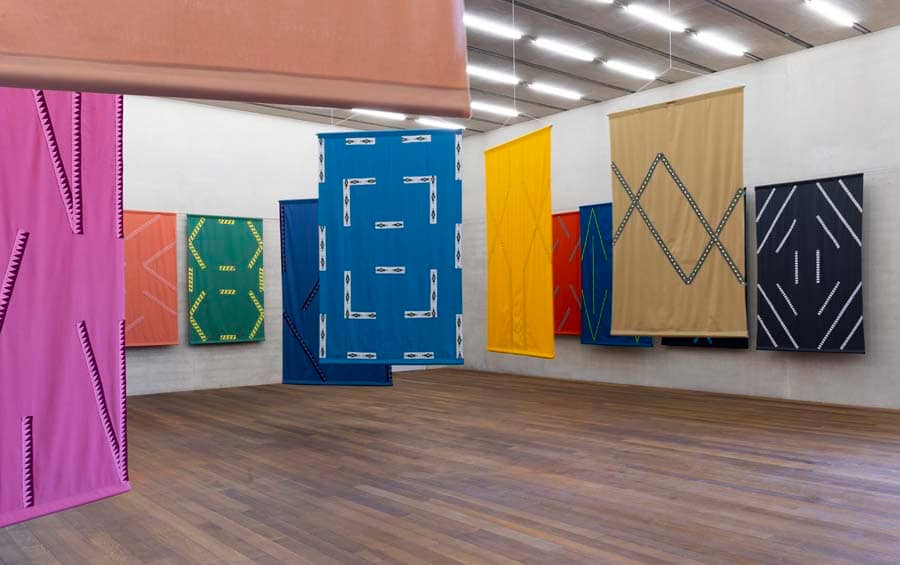Felipe Mujica The Swaying Motion on the Bank of the River Falls

Date
(Thursday May 20th, 2021) - (Sunday May 1st, 2022)
Details
Felipe Mujica (b. Santiago Chile; lives in New York) creates works comprised of installation drawing collapsible sculptures and printmaking. His fabric panels—or curtains as he describes them—operate as both sculptural
Details
Felipe Mujica (b. Santiago Chile; lives in New York) creates works comprised of installation drawing collapsible sculptures and printmaking. His fabric panels—or curtains as he describes them—operate as both sculptural objects and functional architectural interventions. They often serve as modifiable extensions to the space in which they are displayed; some of them are movable redirecting the viewer’s passage through the exhibition and thus proposing a dynamic composition that is not determined in advance but varies depending on the interaction with the work. The geometric designs on many of these curtains are inspired by themes close to the artist or by the work of other artists belonging to the historical avant-gardes such as Alexander Rodchenko and Paul Klee. Another fundamental aspect of his practice is to open up his art to dialogue with others through a socially engaged production. For example in his project for the 32nd São Paulo Biennial Mujica worked in partnership with Brazilian designers and embroiderers from a local community to employ their personal knowledge and techniques to produce the panels. In Mexico for the XIII Bienal FEMSA Mujica worked in partnership with the Wixárikas artisans from Zacatecas to introduce their cultural knowledge and traditional beading method into his abstract designed panels.
At PAMM Mujica will create new works collaboratively with artisans from the Miccosukee tribe in South Florida. The patchwork designs incorporated in traditional Miccosukee garments and decorations represent abstracted interpretations of the natural world in which the tribes are immersed featuring motifs such as alligators rain river wind and even a man on horse—an iconic symbol of colonial power. By incorporating these abstracted yet traditional designs into this collaborative work Mujica conveys his research on geometric abstraction and its history as well as a sensitivity to a metaphysical exploration of the world. While inside the gallery space viewers will be surrounded with approximately 12-15 curtains bearing symbols and patterns of the outdoor world as seen through the Miccosukee eye. Additional curtains will be placed in outside areas of the museum that shall be visible from the gallery’s window. The exhibition space will also be used as a platform for Miccosukee artisans and community members to engage with our public through programming that will share important aspects of their culture and traditions—providing a space for our audiences to reflect and educate themselves on Miami’s well-respected neighbors of today and some of the earliest inhabitants of Florida.
Felipe Mujica (b. 1974 Santiago Chile) studied art at the Universidad Católica de Chile. After art school he co-founded the artist-run space Galería Chilena which operated from 1997 to 2005 first as a nomadic and commercial art gallery and later as a collaborative art project a curatorial “experiment.” In early 2000 Mujica moved to New York City where he currently lives and works. Parallel and interrelated to his own work Mujica has organized and produced numerous collaborative projects including exhibitions and books. Mujica has has had solo shows at Museo de Arte Moderno de Medellín; Casa Triângulo São Paulo; Galerie von Bartha Basel/S-chanf Museo Experimental El Eco México D.F.; Proyectos Ultravioleta Ciudad de Guatemala; Die Ecke Arte Contemporáneo Santiago; and Centro Cultural Matucana 100 Santiago. He is currently working on a solo project organized by Sindicato Las Terrenas República Dominicana. Group shows include Nunca fuimos contemporaneos Bienal Femsa Zacatecas (2018); Incerteza viva 32a Bienal de São Paulo (2016); Ir para volver 12 Bienal de Cuenca (2014); Ways of Working: The Incidental Object Fondazione Merz Turín (2013); Contaminaciones Contemporaneas Museo de Arte Contemporáneo Universidad de Chile Santiago (2012); and Museu de Arte Contemporãnea da Universidade de São Paulo (2011); and 3rd Guangzhou Triennial Guangdong Museum of Art Guangzhou (2009); amongst others.
more